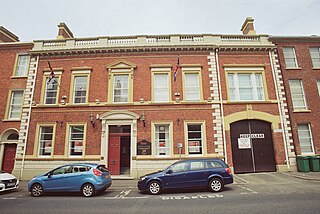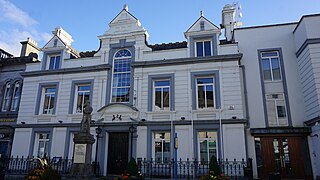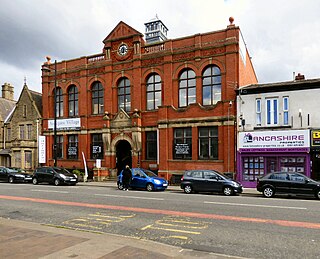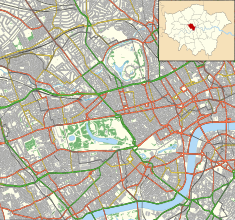
Charing Cross Road is a street in central London running immediately north of St Martin-in-the-Fields to St Giles Circus, which then merges into Tottenham Court Road. It leads from the north in the direction of Charing Cross at the south side of Trafalgar Square. It connects via St Martin's Place and the motorised east side of the square.

Caxton Hall is a building on the corner of Caxton Street and Palmer Street, in Westminster, London, England. It is a Grade II listed building primarily noted for its historical associations. It hosted many mainstream and fringe political and artistic events and after the Second World War was the most popular register office used by high society and celebrities who required a civil marriage.

The Green Man is a Grade II listed public house at 57 Berwick Street, in London's Soho.

Westminster City Hall is a municipal building in Victoria Street in Westminster, London. It is the headquarters of Westminster City Council.

Witham Town Hall is a municipal building in Newland Street, Witham, Essex, England. The building, which is the meeting place of Witham Town Council, is a Grade II listed building.

The Old Town Hall is a building on Church Street in the market town of Poulton-le-Fylde in Lancashire, England. The building, which is located just beyond the northern end of Market Place, started life as a public house before becoming a municipal building and then reverting to use as a public house.

The Corn Exchange is a commercial building in King Street, Ipswich, Suffolk, England. The structure, which is currently used as a public events venue, is Grade II listed building.

The Old Town Hall is a municipal structure in Castle Street, Lisburn, County Antrim, Northern Ireland. The structure, which is used as a constituency office by the Democratic Unionist Party, is a Grade B2 listed building.

The Old Town Hall is a municipal building in the Middlehaven area of Middlesbrough, North Yorkshire, England. The building is on East Street and has been vacant since 1996. It is a Grade II listed building with the adjacent clock tower also separately Grade II listed.

Forfar Sheriff Court is a judicial building in Market Street, Forfar, Angus, Scotland. The building, which remains in use as a courthouse, is a Category B listed building.

The Corn Exchange is a commercial complex in the High Street, Rochester, Kent, England. The complex, which was commissioned as a corn exchange and is now used as an events venue, is a Grade I listed building.

The Corn Exchange is a commercial building in the Market Place, Fakenham, Norfolk, England. The structure, which is currently used as a cinema, is a Grade II listed building.

The Corn Hall is a commercial building in the Market Place, Cirencester, Gloucestershire, England. The structure, which is used as a shopping arcade and community events venue, is a Grade II listed building.

Clonmel Town Hall is a municipal building in Parnell Street, Clonmel, County Tipperary, Ireland. The building accommodated the offices of Clonmel Borough Council until 2014.

Levenshulme Antiques Village, formerly Levenshulme Town Hall, is a former municipal building on Stockport Road in Levenshulme, a suburb of Manchester in England. The building, which served as the offices and meeting place of Levenshulme Urban District Council, now accommodates an antiques centre.

Hoylake Town Hall is a former municipal building in Market Street in Hoylake, a town in Merseyside, in England.

Swaffham Town Hall is a judicial building in Whitecross Road in Swaffham, a town in Norfolk, in England. The building, which is now in residential use, is a Grade II listed building.
The Old Town Hall Chambers is a historic building in the High Street in Newport Pagnell, a town in Buckinghamshire, in England. The building, which served as a public events venue, is a grade II listed building.

Ventnor Town Hall is a historic building in Albert Street in Ventnor, a town on the Isle of Wight, in England. The facade of the building, behind which new flats have been created, is a Grade II listed building.

The Old Town Hall is a municipal building in Mare Street in Hackney, London. The building, which is currently used as a public house, is a Grade II listed building.





















